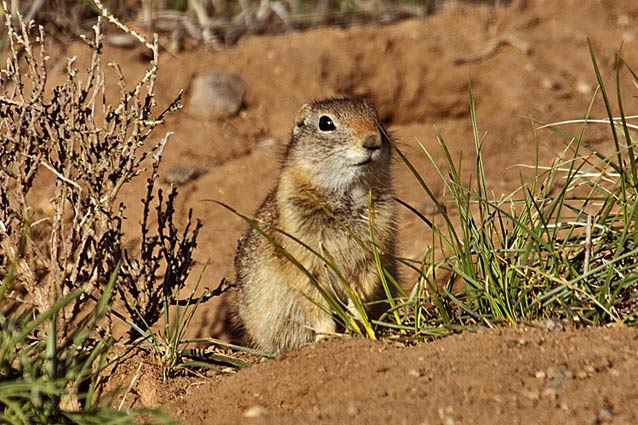Black-tailed Prairie Dogs

© Curtis Carley
The area once inhabited by the black-tailed prairie dog has dramatically declined due to a number of factors, including intensive control programs, conversion of habitat to agriculture, disease (sylvatic plaugue), unregulated recreational shooting, and urbanization. The sylvatic plague, caused by the bacterium Yersinia pestis, is a disease transmitted by fleas; it can be contracted by many different mammals and may kill nearly all prairie dogs in an infected colony (USGS 2008). Management of the black-tailed prairie dog varies substantially across its range where its consideration by different states includes extirpated, species of special concern, wildlife, small game species, rodent, and vertebrate pest (USGS 2009). In Arizona, for example, a multi-partner reintroduction effort released 74 black-tailed prairie dogs from a ranch in New Mexico into the Las Cienegas National Conservation Area near Sonoita in late 2008 (Arizona Game and Fish Department 2008). The ultimate goal of the reintroduction effort is to bring this “critical keystone” species back to Arizona to where it once existed.
The USFWS designated the black-tailed prairie dog as a candidate species for listing under the ESA in 2000 (USFWS 2000). However, in 2004, the USFWS concluded that the prairie dog was no longer a candidate species, due to an earlier underestimate of the area inhabited by prairie dogs, and a likely overestimate of the threat posed to prairie dogs from plague (USFWS 2004). As of 2009, the USFWS is again reviewing biological information on the species to determine whether to propose adding it to the federal list of threatened and endangered species. Comments were accepted from the public on this review until January 30, 2009 (USFWS 2009).
| Area in 2003 and goals for 2011 for states in the Southwest occupied by black-tailed prairie dogs. Taken from Luce et al. (2006). | ||
| State | State Acres Occupied in 2003 | Goal for Acres Occupied in 2011 |
| Arizona | 0 | 4,598 |
| Colorado | 631,578 | 255,966 |
| Kansas | 130,619 | 148,707 |
| New Mexico | 60,045 | 87,197 |
| Oklahoma | 64,263 | 68,708 |
| Texas | 197,149 | 293,350 |
In the late 1990s, in response to the USFWS considering the black-tailed prairie dog for listing, representatives from the eleven states within the prairie dog’s range formed the Interstate Black-tailed Prairie Dog Conservation Team (Luce et al. 2006). The team developed a plan—A Multi-State Conservation Plan for the Black-tailed Prairie Dog, Cynomys ludovicianus, in the U.S. The goal of the plan was to maintain 1.6 million acres inhabited by prairie dogs, and to increase the area inhabited to 1.7 million acres by 2011. Table 1 shows the area inhabited by black-tailed prairie dogs in 2003 and the 2011 goal for states in the I&M Networks in the Southwest.
Gunnison’s Prairie Dogs

USFWS
Numbers of Gunnison’s prairie dogs have decreased for the same reasons as those described for the black-tailed prairie dog. In Spring of 2008, the USFWS announced that populations of the Gunnison’s prairie dog in central and southern Colorado and north-central New Mexico (i.e., those occupying “montane” habitat) met criteria for protection under the ESA. However, listing of the species is considered a lower priority than the listing of other species, so the Gunnison’s prairie dog was placed on the list of Candidate Species.
The Interstate Black-tailed Prairie Dog Conservation Team was expanded in 2002 to include management of the Gunnison’s and white-tailed prairie dogs (Colorado Division of Wildlife 2008). State wildlife agencies within the range of the Gunnison’s began coordinating management efforts and formed a working group. All states within the range of the prairie dog are managing the species, and are developing long-term monitoring protocols.
Prepared by Patricia Valentine-Darby, Southern Plains Network Inventory and Monitoring Program, 2009.
Part of a series of articles titled Prairie Dogs of the American Southwest.
Last updated: May 20, 2015
